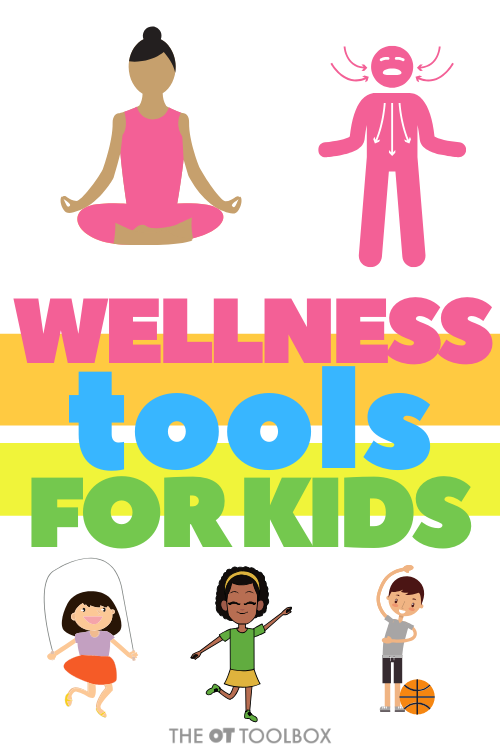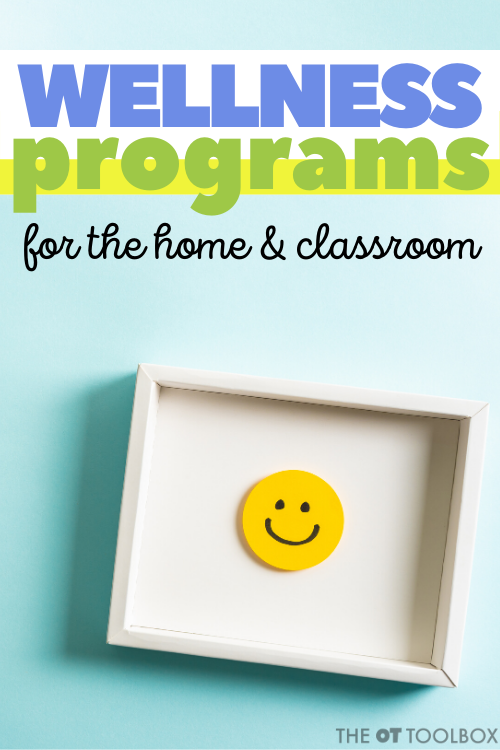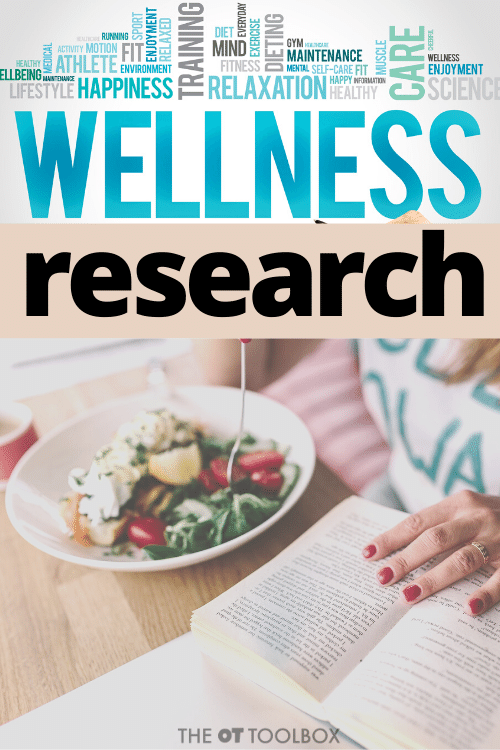Well, there is one thing for sure. When it comes to practice, occupational therapists need evidence. Today, we’re talking about wellness research. We’re discussing aspects of wellness and well being based on the studies and the research that is out there. This wellness information will be a resource for anyone looking to serve and create a wellness plan..whether it be for a clinic, a classroom, an individual, or a family. I’ve dissected various health and wellness articles to bring you the evidence! Grab a cup of coffee or a big glass of ice water, relax, and check out these wellness studies. This post is part of our Wellness Challenge, where we cover all things health and wellbeing for kids and families.

Be sure to check out this post on the wellness wheel to discover the subcategories of wellbeing as well as balance/imbalance and how to determine a state of being.
This post on Family Wellness is a good read, too. Discover wellbeing in the family as a unit or individual.
Wellness Research on Child well being
Occupational therapy practitioners can play a valuable and effective role in influencing the outcomes of child development supporting the health and well-being of families. A healthy family unit has an effect on positive child outcomes, development, and overall health.
Parent Resources for Wellness- We know that child well being is dependent on various factors. There are wellness articles that covers in depth, all of the factors that play into overall child health. This article discusses considerations such as parental resources, parental mental health, parental relationship quality, parenting quality, and father involvement play an important role in child well being. Likewise, the different family types also likely plays a role, as does family stability and instability.
Socioeconomic Factors- Similarly, one study looked at socioeconomic considerations and location as a prediction of well being. It was determined that residing in rural and remote communities may predict the psychological wellness of children and adolescents. The findings from this study (conducted in Australia) concluded that affordable, universal, and accessible services, such as early intervention is needed for children and families living in rural and remote communities is warranted particularly for low income families. These services may balance the discrepancy of mental wellness scores between rural and urban communities.

wellness TOOLS
Wellness studies have been conducted on specific wellness strategies. Components of wellness such as emotional wellness, physical wellness, etc. can be addressed using holistic or psychological interventions such as deep breathing, sensory-based coping tools, or mindfulness. Complementary integrative and holistic therapy approaches may include music, massage, guided imagery, or deep breathing to minimize stress.
Deep Breathing- This study addressed the impact of deep breathing on stress. Imbalance on various aspects of health and well being can result in stress or overload. The results from the study indicate that deep breathing techniques are capable to create an improvement in mood and stress. This has been found in both self-reported evaluations, as well as objective parameters including heart rate and salivary cortisol levels.
Mindfulness- While not a research study or wellness article, this video on mindfulness shares examples of mindfulness-based interventions for children. One study explored whether implementing a mindfulness-based program in kindergarten classrooms influenced self-regulation and
behaviors related to social and emotional competence. It showed that children from classrooms that had participated in a mindfulness-based program showed significant gains in self-regulation and became more prosocial and less hyperactive. Additionally, children that had participated in the mindfulness-based program showed more empathy. The mindfulness-based program also made an impact on children’s maladaptive behaviors related to difficulties in self-regulation (i.e., hyperactivity)
Brain Breaks– This study assessed the use of brain breaks in the classroom to determine effectiveness in the learning experience, self-awareness, self-efficacy, and self-confidence through physical activity. Students participated by using video exercises. The study indicates that exercise habits and holistic wellness tools of brain break activities, along with personal motivation and motivation provided by others impact children’s attitudes for physical activity, motivation, internalization of movement habits as well as self-awareness, self-confidence, and self-efficacy. The study recommends frequent use of classroom based brain breaks as a positive impact on several developmental aspects, as a tool for active break and motivation for physical activity, and as a meaningful tool for establishing cross-subject relations, integration, holistic learning and development.
Deep Breathing– This study assessed the use of yoga deep breathing strategies to impact anxiety and attention in pre-teens. There are several deep breathing strategies that were analyzed while they ere used during the beginning of each school day. The study found that high frequency yoga breathing can improve the ability to focus and shift attention, while reducing anxiety.
Yoga studies
Yoga is known to impact health and wellbeing on many facets. One study found that people who practiced yoga were more likely to do so for wellness reasons than to treat a specific health condition and report better health and wellness as a result. Yoga has many benefits when used in the classroom, including improved psychological well-being, reduced rates of being overweight or obese, children being calmer and more attentive, more at ease, and completing assigned tasks successfully.
This study on yoga found that chronic pain and yoga have significant but opposite effects on the physical structure of the brain.

wellness plans and Programs
Thinking of setting up a wellness program? It’s a fantastic idea! Creating a structured and reproducible wellness plan is an option for intervention, consultation, or coaching. Here is what the research says about wellness plans:
Wellness Plans- In creating a workplace wellness plan, the involvement of leadership matters. This study determined that employees’ perceptions of leadership and their involvement in supporting health promotion impacts employee involvement. Factors such as perceived job stress levels and health behaviors are related to leadership participation in wellness activities.
Wellness in Schools- Wellness programs in the schools benefit employees, too. One study was conducted based on the fact that promotion of wellbeing among employees in the elementary school setting can support students’ health and academic success. In the case of school wellness, teachers and school employees can serve as role models for students. Between busy schedules, exhaustion and high job demands, poor food options, and limitations in time for movement or exercise, there is a high need for school wellness plans.
Classroom Wellness- While this study examined a wellness strategy among college students, the findings are interesting. The study combined wellness education and extra time to practice, reflect on, discuss, and assess wellness skills. Students were led through meditative practice (e.g., yoga, tai chi, sensory nature walks), and workshops on nutrition, sleep, and other wellness topics. By gaining first hand experience in wellness strategies, students were able to fulfill aspects of overall wellbeing, including mental, physical, and intellectual subcategories.
Wellness Rooms– While this study looked at wellness rooms as a tool for surgical nurses in order to reduce workplace stress. Like nurses, occupational therapists and teachers tend to feel a lot of burn out in their professions. The term occupational stress predicts “burn out”. Occupational stress refers to high demands of the job related to work rhythm and intensity), lack of control over the work process, and low social support from managers and peers, all of which may lead to distress and sickness. The “wellness room” included space for rest, physical activity, aesthetic care such as makeup, body massage and skin cleansing, breakfast, free moment for conversation and workers’ interaction, Auricular acupuncture, and lectures and workshops on stress management and coping. This sounds like a wellness program that could be hosted by and created by occupational therapy practitioners!
Wellness via Teletherapy- This article describes a wellness program designed to support families and caregivers of children with Autism spectrum disorder. The unique telehealth program addresses the higher stress levels occurring among caregivers of children with ASD and other developmental disorders by offering effective coping strategies to improve overall health. Through interviews and virtual sessions, caregivers were able to come up with health goals, reflect on needs, and develop strategies alongside an occupational therapist. Wellness strategies were integrated into daily routines to improve motivation, meaning, and follow-through. By participating in the program, mothers were able to consider their own wellbeing and implement wellness strategies while supporting the unique needs of their child.
Workplace Wellness Programs- Do they work? How does wellness in the workplace look? Employee health and wellness programs can be a powerful tool in workplace wellbeing. This study analyzed whether workplace health promotion programs work and how to design a plan that makes for a well-executed program and found that wellness programs that are based on evidence-based principles can achieve positive health and financial outcomes. The study concluded that a favorable workplace culture fosters effectiveness and use of best practice can maximize workplace well being activities. What’s more is that this study found that medical costs fall by about $3.27 for every dollar spent on wellness programs and that absenteeism costs fall by about $2.73 for every dollar spent. These are interesting findings, aren’t they?

So, how can you use this information to design a wellness program or a plan to promote health and well being in kids, families, or in the classroom? There is a lot to think about!
Be sure to join us in the Wellness Challenge here on the website as we go through all things health and wellbeing for kids and those who serve them.
Wellness Research References:
Baicker K, Cutler D, Song Z. Workplace wellness programs can generate savings. Health Aff (Millwood). 2010;29(2):304‐311. doi:10.1377/hlthaff.2009.0626
Goetzel RZ, Henke RM, Tabrizi M, et al. Do workplace health promotion (wellness) programs work?. J Occup Environ Med. 2014;56(9):927‐934. doi:10.1097/JOM.0000000000000276
Hoert J, Herd AM, Hambrick M. The Role of Leadership Support for Health Promotion in Employee Wellness Program Participation, Perceived Job Stress, and Health Behaviors. Am J Health Promot. 2018;32(4):1054‐1061. doi:10.1177/0890117116677798
Jacques, João Paulo Belini, Ribeiro, Renata Perfeito, Scholze, Alessandro Rolim, Galdino, Maria José Quina, Martins, Júlia Trevisan, & Ribeiro, Benedita Gonçalves de Assis. (2018). Wellness room as a strategy to reduce occupational stress: quasi-experimental study. Revista Brasileira de Enfermagem, 71(Suppl. 1), 483-489. https://dx.doi.org/10.1590/0034-7167-2017-0572
Johnson, Jeannine & Bauman, Connie & Pociask, Sarah. (2019). Teaching the Whole Student: Integrating Wellness Education into the Academic Classroom. Student Success. 10. 92-103. 10.5204/ssj.v10i3.1418.
Perciavalle V, Blandini M, Fecarotta P, et al. The role of deep breathing on stress. Neurol Sci. 2017;38(3):451‐458. doi:10.1007/s10072-016-2790-8
Peters, I., Handley, T., Oakley, K., Lutkin, S., & Perkins, D. (2019). Social determinants of psychological wellness for children and adolescents in rural NSW. BMC public health, 19(1), 1616. https://doi.org/10.1186/s12889-019-7961-0
Popeska, B., Jovanova-Mitkovska, S., Chin, M. K., Edginton, C. R., Mo Ching Mok, M., & Gontarev, S. (2018). Implementation of Brain Breaks® in the Classroom and Effects on Attitudes toward Physical Activity in a Macedonian School Setting. International journal of environmental research and public health, 15(6), 1127. https://doi.org/10.3390/ijerph15061127
Schultz, N. S., Chui, K., Economos, C. D., Lichtenstein, A. H., Volpe, S. L., & Sacheck, J. M. (2019). A Qualitative Investigation of Factors that Influence School Employee Health Behaviors: Implications for Wellness Programming. The Journal of school health, 89(11), 890–898. https://doi.org/10.1111/josh.12831
Sood, D., Comer-HaGans, D., Barnec, A., Dowling, K., Kozy, K., Pranske, L., … & Tietz, A. (2018). An innovative approach to promote health and well-being of caregivers of children with autism spectrum disorder. SIS Quarterly Practice Connections, 3(3), 14–15.
Viglas, M. (2015). Benefits of a mindfulness-based program in early childhood classrooms (Order No. 3709578). Available from Health Research Premium Collection. (1699340731). Retrieved from https://search.proquest.com/docview/1699340731?accountid=143111
Waldfogel, J., Craigie, T. A., & Brooks-Gunn, J. (2010). Fragile families and child wellbeing. The Future of children, 20(2), 87–112. https://doi.org/10.1353/foc.2010.0002

Colleen Beck, OTR/L has been an occupational therapist since 2000, working in school-based, hand therapy, outpatient peds, EI, and SNF. Colleen created The OT Toolbox to inspire therapists, teachers, and parents with easy and fun tools to help children thrive. Read her story about going from an OT making $3/hour (after paying for kids’ childcare) to a full-time OT resource creator for millions of readers. Want to collaborate? Send an email to contact@theottoolbox.com.


